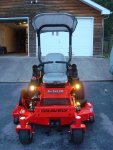You are using an out of date browser. It may not display this or other websites correctly.
You should upgrade or use an alternative browser.
You should upgrade or use an alternative browser.
Should ZTR operators be ticketed if the ROPS bar is removed?
- Thread starter X-man
- Start date
More options
Export threaddjdicetn
Lawn Addict
- Joined
- Sep 3, 2012
- Threads
- 12
- Messages
- 2,193
This is an old thread now. I see that there have been 42 no and 3 yes. I would be curious to know if the three that voted yes run zero turns commercially.
I am one of the yes votes. No, I do not mow commercially. The reason I voted yes is clearly explained in Post#64. If I owned a lawn care business I would(and would require all of my workers to) use the ROPS for the reason(s) I stated earlier.
djdicetn
Lawn Addict
- Joined
- Sep 3, 2012
- Threads
- 12
- Messages
- 2,193
I would like to see where this guy put the zero turn that rolled it. We have had some in some god awful places and to flip one would be incredible. I am sure that it happens. Every place I have ever seen them they just slide to the bottom. I have honestly come closer to flopping mine with the ROPS up hitting something than on a hillside.
My 326 weighs about 1300#'s and the center of gravity is right on the ground. Being belted to the thing with a lap belt and a ROPS would be scarey to me as well because just flipping the thing would more than likely cause something it turned over on to come on on the operator.
The ROPS on a zero turn makes them unstable because of hitting obstructions.
Trick question(s) for all of the "NO" voters....why did ZTR manufacturers decide to put ROPS on a Commercial/Industrial grade ZTR?????? What do the manufacturers recommend(and why)?
Just trying to get everyone riled up again:0)
NOT
Trick question(s) for all of the "NO" voters....why did ZTR manufacturers decide to put ROPS on a Commercial/Industrial grade ZTR?????? What do the manufacturers recommend(and why)?
Just trying to get everyone riled up again:0)
NOT
It was a government mandate ......iirc. Manufacturers only do things if they are threatened somehow.
ROPS legislation was passed in 1975, with OSHA requiring that all tractors manufactured from October 25, 1976 onwards be equipped with ROPS.[4] In 1985, the development of a new voluntary safety standard by the American Society of Agricultural Engineers (S318.10) encouraged an initiative by American tractor manufacturers to equip new tractors over 20 horsepower with ROPS.[5][6] Since then, additional efforts have been made to help increase the adoption of ROPS among tractor owners who are still not using it. In 1993, the five largest North American tractor manufacturers started an incentive program offering ROPS retrofit kits to local dealers to sell to tractor producers, without additional cost.[7] The response by tractor owners to this retrofitting initiative was limited.[3]
Trick question(s) for all of the "NO" voters....why did ZTR manufacturers decide to put ROPS on a Commercial/Industrial grade ZTR?????? What do the manufacturers recommend(and why)?
Just trying to get everyone riled up again:0)
NOT
I just noticed - IN YOUR picture - your's is down , can you please send the 2500.00 fine to my house.:laughing:
djdicetn
Lawn Addict
- Joined
- Sep 3, 2012
- Threads
- 12
- Messages
- 2,193
I just noticed - IN YOUR picture - your's is down , can you please send the 2500.00 fine to my house.:laughing:
I never updated my avatar picture(taken day of delivery). I have since installed a bimini sunshade, so lowering the ROPS is no longer an option. Besides...I re-emphasize....IMHO, "consumers" should not be "required" to have an active ROPS, only someone being paid for mowing with a ZTR. I've not "digested" the detailed information you provided regarding the OSHA mandate, but it confirmed what I kinda assumed.
Since it does appear I am guilty of a "double standard" I will try to find a more recent picture to post to this reply:0)
Attachments
A_tank96
Well-Known Member
- Joined
- Sep 29, 2012
- Threads
- 14
- Messages
- 119
Next will come a full cage and 5 point racing belts
I believe if they roll the machine and hurt themselves or somebody else, They don't know how to use the machine, or they are pushing it to hard, and that is their own fault.
Aaron
Carscw
Lawn Pro
- Joined
- Aug 11, 2011
- Threads
- 66
- Messages
- 6,375
I believe if they roll the machine and hurt themselves or somebody else, They don't know how to use the machine, or they are pushing it to hard, and that is their own fault. Aaron
I agree 100%
Ric
Lawn Pro
- Joined
- May 7, 2010
- Threads
- 139
- Messages
- 5,765
It was a government mandate ......iirc. Manufacturers only do things if they are threatened somehow.
ROPS legislation was passed in 1975, with OSHA requiring that all tractors manufactured from October 25, 1976 onwards be equipped with ROPS.[4] In 1985, the development of a new voluntary safety standard by the American Society of Agricultural Engineers (S318.10) encouraged an initiative by American tractor manufacturers to equip new tractors over 20 horsepower with ROPS.[5][6] Since then, additional efforts have been made to help increase the adoption of ROPS among tractor owners who are still not using it. In 1993, the five largest North American tractor manufacturers started an incentive program offering ROPS retrofit kits to local dealers to sell to tractor producers, without additional cost.[7] The response by tractor owners to this retrofitting initiative was limited.[3]
Pardon me but what does all this government mandate stuff have to do with the subject or what equipment were using??

